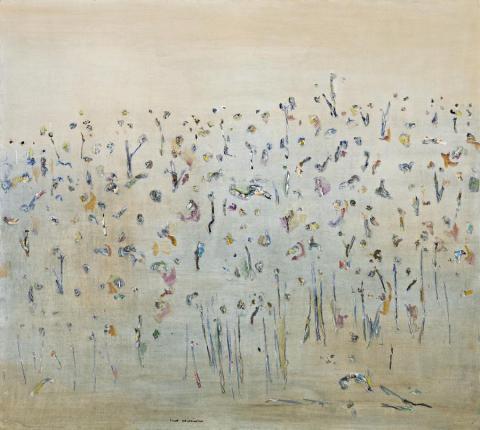HILLSIDE AT LYSTERFIELD II, 1967
Fred Williams
oil on canvas
137.5 x 153.0 cm
signed lower centre: Fred Williams
The Estate of Fred Williams, Melbourne
Lyn Williams Collection, Melbourne
Deutscher~Menzies, Melbourne,1 May 2002, lot 30 (illus. front cover)
Private collection, Sydney
Fred Williams: A Retrospective, National Gallery of Australia, Canberra, November 1987, then touring nationally
Mollison, J., A Singular Vision: The Art of Fred Williams, Australian National Gallery, Canberra, 1989, p. 102 (illus. p. 105)
Hillside Landscape, 1966, oil on canvas,134.5 x 142.5 cm, collection of The News Corporation
Hillside at Lysterfield I, 1967, oil on canvas, 111.8 x 127.0 cm, Private collection
Lysterfield Triptych, 1967–68, oil on three canvases, 152.5 x 122.0 cm, 152.5 x 183.5, 152.5 x 122.0 cm, collection of the National Gallery of Australia, Canberra
Fred Williams is rightfully acclaimed as one of Australia's finest artists of the twentieth century. As a landscape painter he has no equal, Hillside at Lysterfield II 1967 being one of a number of masterpieces that gives him that honour. His solo exhibition at Georges Gallery, Melbourne in the spring of 1967 opened to great applause. The art critics enthused. Patrick McCaughey in The Age declared that Williams 'has established himself as the most exciting landscape painter in Australia, and for sheer originality of vision Williams stands quite apart in Australian painting.'1 Alan McCulloch of the Melbourne Herald said that 'A truly revolutionary spirit can be found in Fred Williams's superb landscapes at Georges.'2 In recollection, these comments effectively recall the excitement, quality and impact Williams's work had at the time. We were witnessing the emergence of a brilliant new star in the heavens of Australian art, and the range of oil paintings and gouaches in this exhibition were unforgettable. Covering the few years from 1965 to 1967, the show included You-Yang landscapes, an Upwey painting already in the collection of Mr and Mrs Gordon Darling, with Mark Besen, Rudy Komon and the Reserve Bank of Australia among the other lenders. Rupert Murdoch had acquired Hillside Landscape Lysterfield 1966-67, and Lysterfield Landscape II 1967 went into the collection of Sir Roderick and Lady Carnegie. Lysterfield inspired Williams to further heights such as the large Triptych Landscape 1967-68 in the collection of the National Gallery of Australia, Canberra. And Geelong Art Gallery's Yellow Landscape 1968-69, has been described by McCaughey as 'the crowning glory of the whole Lysterfield group...'.3
'At Lysterfield' as his close friend James Mollison points out, 'he often had to paint from the edge of the road, and tall foreground grasses are the key to many of his Lysterfield paintings.'4 These vertical signature marks are the key to these superb paintings, seen in Hillside at Lysterfield I 1967 and our painting. Both developed out of Hillside Landscape 1966 in the collection of News Corporation.5 Hillside at Lysterfield I was painted in March with 'yellow & lilac everywhere'.6 Lysterfield Landscape II is a slightly larger reworking of the subject in seasonal 'cool tones and a greater elaboration of marks.'7 Atmospherically engaging, the horizon fades in the openness of vision and 'pink haze over everything'.8 Mollison noted, 'In the second work, the touches of rose madder lie on top of the first layer of varnish, and may have been added months or even years later in memory of the pink haze the artist had seen.'9 Painted over a period of about four years, the Lysterfield landscapes contain some of Williams's best work. Hillside at Lysterfield II 1967, distinguished by its painterly spontaneity and assurance, the defused handling of the various motifs, and delicate rainbow colours, makes it one of the finest.
1. McCaughey, P., 'A Painter Apart', Age, Melbourne, 27 September 1967, p. 6
2. McCulloch, A., 'Landscape Revolution', Herald, Melbourne, 27 September 1967, p. 19
3. McCaughey, P., Fred Williams, Bay Books, Sydney, 1980, pp. 190-91
4. Mollison, J., A Singular Vision: The Art of Fred Williams, Australian National Gallery, Canberra, 1989, p. 100
5. See Mollison, ibid., pp. 104-5 for comparative colour illustrations
6. Williams's diary 28 March 1967, quoted in ibid., p. 102
7. Mollison, op. cit., p. 102
8. Williams's diary 25 June 1967, quoted Mollison, op. cit., p. 102
9. Mollison, op. cit., p. 102
DAVID THOMAS
